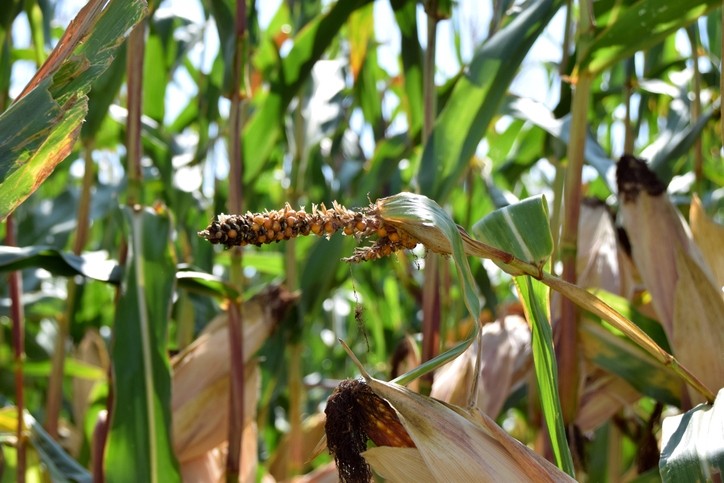Special Edition: Mycotoxin Risk and Control
KSU team identifies level of fumonisin contamination of feed that hinders pig growth

Sphingolipids and their synthetic enzymes are emerging as important mediators in inflammatory responses and as regulators of immune cell functions.
The KSU team carried out an experiment to note the effect of feeding fumonisin-contaminated corn on growth performance and sphinganine (SA) to sphingosine (SO) ratios of 9 to 28 kg pigs.
And, in doing so, they identified the SA:SO ratio as a critical biomarker for fumonisins’ negative effect on pig growth performance.
Mike Tokach, from the Department of Animal Sciences and Industry, College of Agriculture, KSU, told FeedNavigator:
“The main conclusion from the paper is that feeding diets containing more than 20 ppm of fumonisins reduces growth performance and impairs lung function. In simple terms, a high SA:SO ratio, meaning a ratio over 1.0, is an indication of impaired lung function.”
The SA:SO ratio is a good diagnostic tool, he said. But there are current limitations around using it as a biomarker to track fumonisin linked health degradation in animals.
“The SA:SO ratio is not easily measured because there is only one laboratory that we could find that was able to measure the ratio and it is also relatively expensive to measure. Thus, it can be useful as a research tool, but isn't applicable in the field as a diagnostic tool at this time,” explained Tokach.
High doses (above 100 mg/kg of feed) of fumonisin contamination in swine feed for a short period of time (around three to five days) can cause acute porcine pulmonary edema (PPE), which is often lethal, reported the researchers.
The US Food and Drug Administration (FDA) established a guidance level of 20 mg/kg total fumonisins (B1 + B2 + B3) as a maximum in corn used for swine feed and, at this level of contamination, corn should not exceed 50% of the diet.
The European Commission also established a recommendation for fumonisin (B1 + B2) levels for corn used in animal feed to be below 60 mg/kg and no more than 5 mg/kg in complete swine diets.
The results of the KSU team’s study, published in the journal Toxins, confirm that the higher the fumonisin level, the faster the SA:SO ratio increases.
Why did they carry out this piece of research?
“To our knowledge, there is limited data on the concentration of naturally fumonisin-contaminated corn that affects pig growth performance and serum SA:SO ratio. Because co-occurrence of fumonisin with other mycotoxins in nature is common, most previous studies have determined the effects of fumonisin on pigs by utilizing purified fumonisin toxin or cultured feed material but not corn naturally contaminated with fumonisins.
“The corn used in this study had high naturally contaminated fumonisin concentrations without detectable levels of other mycotoxins. This allowed us to exclude the interactive effects of multiple mycotoxins on growth performance and the serum SA:SO ratio.”
Methodology
The KSU study saw a total of 350 pigs in the cohort, with five pigs per pen and 14 pens per treatment.
Dietary treatments contained fumonisin-contaminated corn (50 mg/kg of fumonisin B1 + B2) blended with low fumonisin corn (10 mg/kg of fumonisin B1 + B2) to provide dietary fumonisin concentrations of 7.2, 14.7, 21.9, 32.7, and 35.1 mg/kg, outlined the team.
Findings
From day 0 to 28, increasing fumonisin concentration decreased average daily gain, average daily feed intake and gain:feed ratio, observed the scientists.
The greatest reduction in performance was in pigs fed with 32.7 and 35.1 mg/kg of fumonisin (B1 + B2), they said.
Increasing fumonisin concentration increased the serum SA:SO ratio on day 14 and 28, they reported.
For 9 to 28 kg nursery pigs, increasing fumonisin linearly decreased average daily gain and gain:feed ratio. However, despite the linear response, diets containing up to 21.9 mg/kg of fumonisin did not have as dramatic a decrease in growth performance as those fed more than 32.7 mg/kg, they said.
“Further research is warranted to determine the effect of fumonisin concentrations between 21.9 and 32.7 mg/kg.”
Even though mycotoxin-contaminated corn may have reduced oil content, the chemical analysis of the diets showed no difference in major nutrient values among treatments, they added.
“Therefore, the reduced growth performance is likely not a function of nutrient value differences between the two corn sources but is possibly caused by disrupted gastrointestinal function and other negative effects on organs, such as the heart, liver, and kidneys attributed to the increased fumonisins.”
Source: Toxins
DOI: https://doi.org/10.3390/toxins12090604
Title: Effects of Fumonisin-Contaminated Corn on Growth Performance of 9 to 28 kg Nursery Pigs
Authors: ZX Rao, MD Tokach, JC Woodworth, JM DeRouchey, RD Goodband, HI Calderón, SS Dritz













